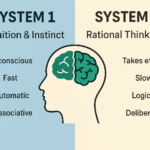For the last two decades, the digital economy has run on a simple transaction: the click. But that era is ending. With the rise of Google’s AI Overviews, which deliver direct answers to user questions, the fundamental trigger for online advertising – the user click – is becoming obsolete.
My recent academic research, as part of my Master of Behavioural Economics at UTS, delves into a phenomenon the industry is calling the ‘Great Decoupling’. This is the new reality where a business’s online impressions remain stable while its clicks decline sharply. The data is striking: studies show AI Overviews reduce clicks on top organic results by 34.5% and on paid ads from 21.27% down to just 9.8%.
Google’s current ad system was built for a referral web that sends users elsewhere. As AI turns search into a generative interface that provides answers directly, the system’s core assumption – that a click is a reliable proxy for value – has collapsed.
So, if clicks are no longer the measure of success, what is? My research models a future where visibility and growth will be driven by new forms of digital capital.
Forecasting the new rules of search
1. Demonstrable authority as a prerequisite
As AI makes it easier to create content, it will become harder to prove credibility. In this environment, search engines will have to prioritise sources they can verify as authoritative and trustworthy, especially in high-stakes ‘Your Money or Your Life’ (YMYL) topics.
My research models the rise of an ‘Authority Gate,’where having proven expertise will be the non-negotiable price of entry for visibility.
2. Longitudinal trust across the journey
The current ‘last-click’ attribution model is a known flaw; it ignores all the valuable interactions a customer has with a brand before they finally decide to act. The future marketplace will need to reward this early-stage influence. We can expect a shift toward a system that measures and rewards the trust you build across the entire user journey, linking the value you provide during initial research to the conversions that happen days or weeks later
3. Citable influence drives downstream engagement
In a world of ‘zero-click’ searches where users get their answers without leaving Google, the most valuable form of visibility is becoming the citation. Being featured as a source within an AI Overview is the new top-of-funnel impression. The goal for businesses is no longer just to be a clickable link, but to become a foundational primary source that the AI itself trusts and references.
4. Agentic action as the final conversion
The ultimate evolution of this trend is Google’s AI Mode, which facilitates:
- agentic actions. This is where the AI doesn’t just provide an answer; it completes a task directly for the user—booking a purchase or scheduling a consultation entirely within the search interface. This transforms Google from a simple referral engine into a powerful
- execution layer. In this agent-driven world, being the trusted, integrated partner that the AI chooses to execute a command with is the final and most valuable form of conversion
The strategic response: Dual-Intelligence Architecture (DIA)
The move from clicks to credibility isn’t just a technical evolution – it’s a fundamental rethink of how digital authority is built and how businesses connect with their audience in the AI era. Dual-Intelligence Architecture (DIA) is designed for this new landscape, where both AI systems and human users shape your brand’s visibility, trust, and growth.
What is DIA?
DIA is a holistic framework for building your digital presence so it works for two audiences at once:
- AI systems that parse, rank, and cite your expertise
- Human users who ultimately make decisions, engage, and convert
Rather than treating technical SEO and user experience as competing priorities, DIA unifies them into a single, strategic system—so you’re discoverable, trusted, and actionable at every stage of the journey.
How DIA works: Upstream and downstream
1. Upstream: Machine-first authority
- Build a structured, machine-readable knowledge corpus.
This means creating deep, entity-rich content (pillar pages, topic clusters, schema) that AI can easily parse, understand, and validate. - Prove your expertise to the machine.
The goal is to earn citations and be recognised as a trusted source by AI-powered search engines and generative answer systems. - Authority is the new price of entry.
Only brands that pass this machine-level credibility filter will be surfaced in zero-click answers, AI Overviews, and agentic search results.
2. Downstream: Human-first engagement
- Leverage machine-earned trust to attract qualified users.
Once AI recognises your authority, it surfaces your brand to users who are already primed to trust you. - Deliver a seamless, human-centric experience.
Your website and digital touchpoints must convert this pre-qualified attention into meaningful action – whether that’s a direct enquiry, a consultation booking, or another high-value conversion. - Enable agentic actions.
As AI systems begin to handle tasks on behalf of users, your authority ensures you’re the chosen provider when an agent books, buys, or refers – often without the user ever visiting your site.
Why DIA matters now
- Machine trust is the new upstream UX.
Optimising for AI isn’t a technical afterthought – it’s the foundation for being found, cited, and recommended in the first place. - Human experience is still essential – but it starts after trust is earned.
The most valuable users arrive already convinced by the machine’s endorsement. Your job is to make their next step frictionless and rewarding. - DIA is about building a durable, differentiated presence.
In a world of AI-driven discovery, it’s not enough to chase traffic. You need to become the source the machine trusts– and the brand people remember.
The path forward: From clicks to corpus
The most critical investment a business can now make is in building an enduring, authoritative knowledge corpus. It is this asset that will navigate the new AI-driven journey from machine validation to human trust, finally replacing the outdated currency of clicks with the lasting value of citations and agentic action.
Read the full paper published on Social Science Research Network (SSRN) here: Beyond the Click: The New Currencies of the AI Search Era
Figure: A flowchart of the potential new marketplace, illustrating its dual-stage process. Stage 1, the ‘Attention Auction’ , handles informational queries and issues a ‘Trust Token’ to reward influence , while Stage 2, the ‘Action Auction’ , leverages that token to fulfill transactional or agentic commands.


